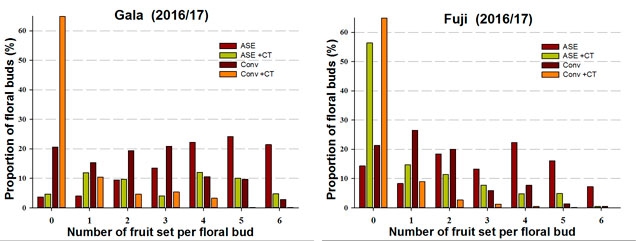Under conventional tree management it is not uncommon to see 30-50% of spur and terminal buds failing to set fruit.
Flowering and fruit set (cont from last month)
Under conventional tree management it is not uncommon to see 30-50% of spur and terminal buds failing to set fruit.
Even allowing for the unusual spring in 2015, the proportion of buds setting multiple fruit was higher in ASE treatments than in the conventionally managed trees, and this effect was even more marked in the second season (Figure 3), with 20% of buds failing to set in both cultivars.
In Gala, chemical thinning did not increase the proportion of buds failing to set in ASE managed trees, unlike the conventional trees where chemical thinning increased the proportion of buds with no fruit from 20% to 65%. In Fuji, chemical thinning increased the number of buds failing to set in both ASE and conventional trees.
Even though the number of flower buds was reduced in the ASE managed trees, the percentage fruit set was higher than in conventional trees (see Figure 4).
This is explained by a high percentage of clusters setting fruit with a higher proportion of multiple fruit set in each cluster.
These results are in agreement with our earlier work showing that most floral buds set fruit under ASE management, most likely due to stronger buds and less competition for resources.
Chemical thinning was more effective in the second year of the study, reducing fruit numbers by approximately half across all treatments.
Total yields
In year 1 of this study, total yield (tonnes per ha) was around 60 t/ha in the Gala for all treatments, with chemical thinning having no real effect, but in the Fuji, yield was 30% higher in the ASE trees than the conventional and chemical thinning further reduced yield in both cultivars (Figure 5).
In the second year, ASE produced higher yields in both cultivars.
Conclusion
ASE is a suitable tool for precision management of crop load without additional chemical thinning.
It has marked advantages in that it is not weather dependent and it removes the negative impact that most chemical thinners have on fruit size and shape.
In addition, bud position is optimised in ASE, fruit is well spaced and light distribution into the canopy is enhanced.
With this technology, growers are also able to set their trees up to carry a predetermined crop load with reasonable accuracy, thus enabling improved management of fruit size.
A full cost:benefit analysis is still to be completed, taking into account time of pruning and bud removal, cost of spraying, hand thinning etc., but our results indicate the potential of ASE to supersede and eliminate the present requirements for chemical thinning to regulate biennial bearing and crop loading.
Although the first year of ASE implementation can be labour intensive, in the longer term the application of ASE with its simplified hand-thinning and more even fruit maturity, combined with a move away from chemical thinning, is likely to reduce both time and cost to the grower.
See this article in Tree Fruit Nov 2017






















